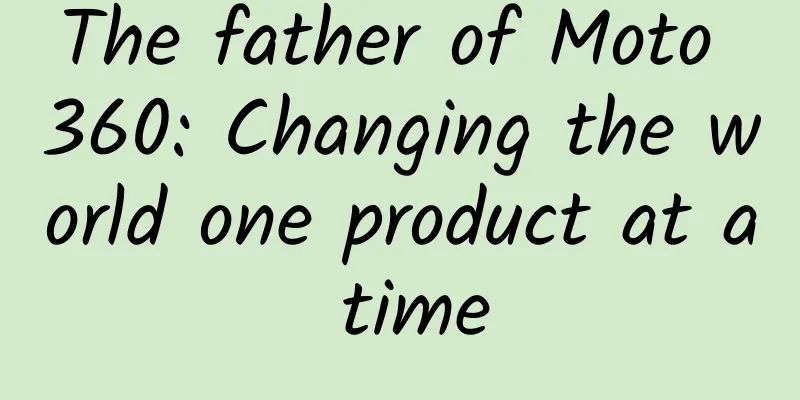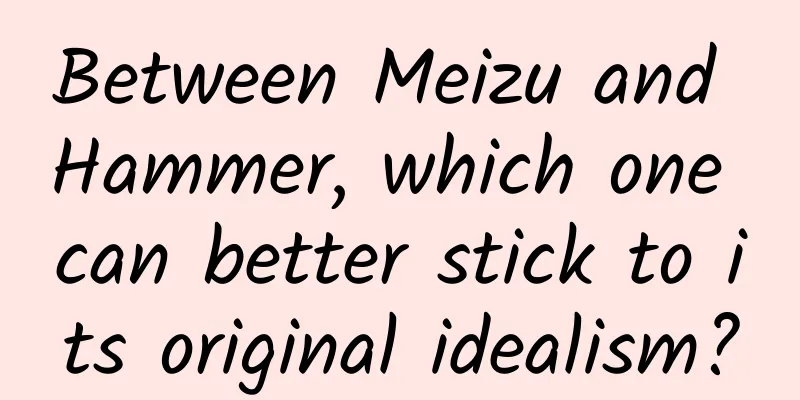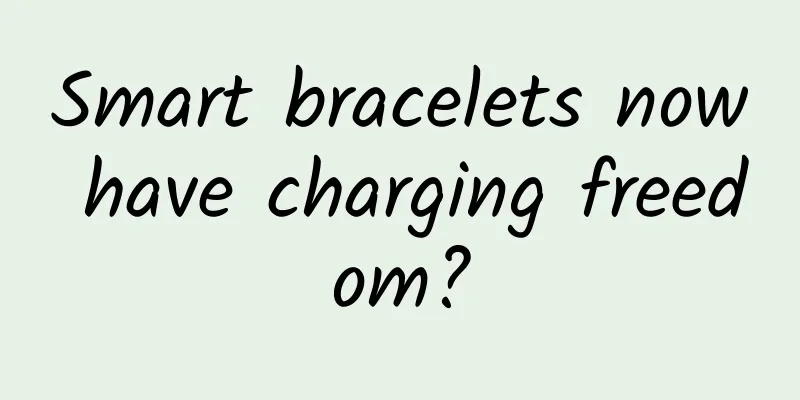The father of Moto 360: Changing the world one product at a time

|
[Key Points] Lior Ron is a Silicon Valley product expert who has developed classic products such as Google Map, Moto X and Moto 360. Weibo WeChat Twitter In the words of my colleague Sophie, Lior Ron is the kind of uncle next door who looks cute. We met in a cafe on Stanford University Road. Although we were huddled in a small corner, four people still recognized him and came to greet him - among them were his colleagues and friends, and the last one was his pregnant wife. Although Lior looks cute, his experience is amazing. He first started his career in the Israeli Military Intelligence Agency, the legendary "Oman" organization. He was the technical director of the organization's intelligence information system and often had to hold all-night meetings with the Israeli Prime Minister, Defense Minister and Chief of General Staff. Later, he came to Silicon Valley in 2005 and worked briefly in Yahoo's search department, but soon started his own business. The company was acquired by Google six months later, so Lior joined Google and began a decade-long product journey, during which he grew into the most famous product person in Google and even the entire Silicon Valley. At Google, Lior was responsible for the development of several products. He was the product manager of Google Map, and he developed this product from 10 million users to 1 billion users in 5 years. In 2011, Google acquired Motorola's mobile division for a whopping $12.5 billion. Lior then joined Motorola, traveling back and forth between Chicago and Silicon Valley, deeply integrating Motorola's hardware advantages with the Android system, and was the main person in charge of Moto X and other major products. Later, Lior led Motorola's smart watch team and officially released the Moto 360 smart watch in September 2014. This product has a beautiful design, and both software and hardware are superior. Once it was launched, it completely beat other smart wearable devices on the market. It was this product that made many people interested in smart wearable devices for the first time. It is hailed as a classic milestone product. In October 2014, Google sold Motorola to Lenovo, and Lior returned to Google during the same period. Lior's Twitter page says "Changing the world, one product at a time." From our conversation, we can also feel his passion for products and clear product design concepts. In addition, Lior praised Chinese products such as WeChat, DJI, Xiaomi and OnePlus, and said that he must have in-depth exchanges with Chinese product people if he has the opportunity. Perhaps in the near future, we will see this product expert at Geek Park's events.
Geek Park: Let’s talk about the problems and interesting stories encountered during the development of Moto 360. Lior: When we first started this project, many things were unreliable. There was no round surface, no high-quality display technology, and there were many technical limitations. However, at the time, I didn't think about these at all. Thinking too much will make you hold yourself back. It took us three years of trial and error to get to the current version. I think it is valuable to accept the "completely unlimited thinking mode". As long as it is useful to users, we need to do our best to achieve it. Geek Park: This sentence reminds me of what Zhang Xiaolong, the father of WeChat, said. He is regarded as the best product manager in China. He said that the most difficult thing about making products is to break out of the fixed mindset. Lior: Yes, I totally agree. I actually like WeChat as a product, but unfortunately not many of my friends use it. I have also participated in the development of some social applications, and one of my friends is the founder of ICQ. I know it was once very popular in China. However, many similar software can do well, and at the same time they may stop breaking the rules. Zhang Xiaolong successfully imagined how a social application can introduce so many user scenarios: games, small merchants, business, payment, etc. The difficulty is to break through the existing model. It is difficult not to mind the existing limitations and boldly imagine the future. I think Zhang Xiaolong did a great job in this matter. Geek Park: Products like WeChat have actually changed the lifestyles of many people. Lior: I understand. Yes, people's social habits have changed a lot in today's society, and communication time has become more and more fragmented. We have gone from books to blogs to social networking sites to Twitter, and now to emojis. What excites me is what the future of communication will be like. The speed of our current communication is not a few minutes or seconds, but can happen instantly, which will be the future of the most cutting-edge communication. Geek Park: So you think watches can also be a tool to help communication? Lior: Exactly. The core of communication is to reduce friction and make things easier. The current way of communication is still full of friction for me. For example, I want to communicate with my wife, a very close person like you, you contact many times a day. That is to ask questions like "How are you?" In order to send a "How are you?" that only takes two seconds to type, I need to put my hand in my pocket, unlock my phone, and open my app. These actions will take me ten seconds, which means I wasted ten seconds for two seconds of communication. This is ridiculous. Why would I do this? When we eliminate these "frictions" we can communicate more and more easily. This will definitely happen. Geek Park: How do you think wearable devices will change the way humans communicate in the future? Lior: As it stands, there are two arguments about how wearables will affect human communication. Research shows that 60% of our frequent daily communications are brief. The first argument is that wearables will save me a lot of time in frequent daily communication. For short communications like the above, wearables can handle them more quickly, allowing us to pay more attention to the people around us. The other argument is that it will distract people and make them use it more to communicate. For example, I can communicate with an app that only has emoticons, send an emoticon, and my communication is complete. With less friction, I may send more messages. I think sending messages is inseparable from wearables and they influence each other. Wearable devices do not have keyboards, but how to send messages without a keyboard becomes a very interesting thing. Geek Park: What is the most used application on your smartwatch? Lior: I am a sports fan, so I use my watch to check the results of sports games. I also like to use it to check my exercise status, such as how many steps I take every day. Some sports apps will also tell me my exercise data after I exercise. There are also some very beautiful watch screens that I like to use. I also like Ticwear developed by the Chinese team. Are smart watches used by everyone in China now, or are they only popular among geeks? Geek Park: At present, the audience is mostly geeks. However, with the exception of Apple Watch, Apple fans will buy any Apple product. Lior: Yes, this reminds me of another direction for wearable devices in the future, which is to make the product beautiful and fashionable. As a product manager, my team and I set our sights on making a watch, not a smartwatch, at the beginning of the design of Moto 360. We want to create a product that looks fashionable. When I wear our watch, people will ask me, "Huh? This watch is pretty." They won't ask me, "Your smartwatch, what can it do?" This is my goal. People often buy such products because these products tell people around them what kind of person they are. This is why we buy different clothes and shoes according to our preferences. What you choose to wear is to convey a message to the people around you. A message about what kind of person you are. We all communicate with the products we wear. This should be the most exciting thing for me in the future of wearable devices. Now the display technology is mature, and it was impossible to have the current effect in the past. Round dial displays are already very common. When the technology is mature, we can make the product more and more beautiful. Moreover, many fashion brands have joined the design of wearable devices and told us their ideas and designs. There are two benefits to their participation. First, they have a tradition of making beautiful products, and their goal is to produce a fashion product rather than a technology product. Second, their participation will bring a brand effect. Sometimes people buy things based on the brand. For example, the Mote 360 in my hand, with the logo of a technology company and the logo of Cartier, people's desire to buy will be completely different. Of course, I also admire the products made by ourselves and companies such as Samsung before, but when you don't think of yourself as a geek. Geek Park: It seems that you also have a deep understanding of fashion products. Lior: You go into a store and you want to buy a watch. Most people don't want to buy a consumer electronics brand watch. You might want to buy a GUCCI or MICHEAL KORS watch. The brand effect is still very big. I think this will be the direction of the next generation of wearable products, the fusion of technology and fashion. I think Apple is a very interesting company because it has the characteristics of a technology product, but also has a certain brand effect. Apple is leading consumers in this direction. When you go to an Apple store to shop, their store is not like a consumer electronics store, but more like a fashion brand store. Another thing that makes me very proud is that the Moto 360 watch is also available in Bloomingdale's (one of the largest department stores in the United States). I think it is the first Motorola product in history to be sold in Bloomingdale's, and I also believe it is the first smartwatch sold in Bloomingdale's. There are two very interesting trends in the future. One is to see how fashion and technology merge, and the second is to see how communication methods and wearable devices influence each other. Now is still the tip of the iceberg, and it has just begun. Geek Park: You started out working for Google, then went to Motorola, and now you’re back to Google, right? Lior: Yes, we bought Motorola three years ago, and Larry (Google CEO) asked me to join Motorola. I am very happy there, and my colleagues are great. Motorola gave me a completely different experience as a product manager, allowing me to learn a lot about hardware product manufacturing, and also gave me an opportunity to put aside all resistance and restrictions and create a hardware product. This process is very difficult, and we tried it out bit by bit. In terms of mobile phones, we are also working hard to make personalized products. Because it goes back to my argument. What people wear and use are ways to show themselves to others. Motorola produced the first mobile phone with wood/bamboo as the back panel. It is very complicated to integrate such materials into mobile phones. First, you have to find a material that will not crack, then process it so that it will not be scratched or rotten, and it must be thin enough, and finally you have to find a sustainable forest. This took us a lot of time and energy. Geek Park: That sounds really interesting. Lior: Here are some prototypes of the Moto 360 that were developed. (He opens a small leather bag but does not allow for photography) At first, there was no circular display, the screen was small, and the watch was thick. Later, we tried to increase the display area, but we still couldn't achieve a circular display, and it still looked like a smartwatch. Later, we improved it to what it is now. I had a lot of fun creating hardware products, and then I returned to Google a few months ago after Motorola was sold to Lenovo. Now a lot of interesting things are happening in Silicon Valley. Originally, everything was related to software, but now, everyone is doing all kinds of things, even making cars. Three or four years ago, Tesla's doing this kind of thing was beyond imagination. Geek Park: You have worked at both Google and Motorola. What do you think are the differences between the corporate cultures of these two companies? Lior: That's a good question. The genes of these two companies are completely different when they started. I think culture comes from basic needs. You create a company culture to fulfill the mission of that company. Google started with software, and the culture is more relaxed, fast-paced, and requires trial and error. A lot of innovation is bottom-up. However, Motorola started with hardware, and a lot of execution is top-down. That's because at Motorola, the cost of making a mistake is very high. In hardware production, a small mistake can cost a lot. In the software industry where Google is, if you make a mistake, you may just change a line of code to solve the problem, or release a new version next week. At Google, a product manager will make product plans six months in advance, while at Motorola, you need to plan one and a half to two years in advance. I need to imagine the market situation two years later. And predict how many products I will produce. However, these two companies also have similarities. First, the two companies share a culture of engineers. Second, both companies pay attention to consumers. The concept of consumer first is also a culture shared by both companies. When I went from software to hardware, the jump was indeed huge. However, the commonality is that they consider consumers more. Because whether it is software or hardware. Satisfying consumers is the ultimate goal. The cultures of these two companies are different, but they also have many similarities. Geek Park: Lenovo bought Motorola, why did you return to Google? Lior: This is a difficult decision. I enjoyed my work at Motorola and learned a lot. However, Larry asked me to come back. It was hard to refuse. I am a person who loves products and I hope to make products for many consumers. Google is a good platform to achieve this. First of all, Google is a visionary company that can think about things five or ten years later. Second, it has the resources and people to accomplish this. I hope to use my own abilities to make better products for consumers on this good platform of Google. Geek Park: Do you think hardware innovation will become very hot in the future? Lior: This is already the case. I think you all know how much innovation is happening in China, and many excellent hardware companies are emerging in Shenzhen. I think there are a lot of consumer innovations happening now. For example, DJI is doing very well. We talk about the "Internet of Things". It's true that the cost of connecting things to the Internet is so low now. Geek Park: I saw you shared a video of the Lily drone on your Twitter. Lior: Yes, Lily is great. Everyday things related to life are connected to the Internet, such as your toothbrush. Colgate has a product. After you brush your teeth, you can see where you didn't brush by looking at your phone app, and then brush again. Even if you don't look at your phone, there is an electric motor inside to guide you to the place you didn't brush. Another example is the trash can. I remember that Barcelona has connected the trash can to the cloud, so the government can know what kind of trash is thrown in the trash can, which can help them do resource recycling more efficiently. They will also know which trash cans are almost full, so they can collect the trash. This is very exciting to me. Geek Park: What role do you think China plays in this round of innovation wave? Lior: I am very happy to see a lot of experimental attempts in China. There are four factors that make China particularly interesting. First, many people in China are doing all kinds of experiments and technological innovations, which is great. Second, they are not afraid of failure and are willing to accept challenges. Third, the cost of entering the Chinese market is low, and the cost of making product prototypes in China is very low, which is an opportunity. Fourth, the Chinese market is huge. So combining the above four aspects, China is a great soil for technological innovation. With this round of technological innovation, we gradually see large consumer electronics companies emerging from China and becoming famous worldwide. Because they meet some needs that consumers themselves have not thought of. I think DJI is a good example. We will see more and more such examples. If you ask people around us what Chinese consumer product brands they know, they should say Lenovo, DJI, Xiaomi, and OnePlus. The reason I like these products is that they are not copied, they are innovating in their own way. Geek Park: Do you really think so? However, in the United States, many people say that Xiaomi plagiarizes. Lior: No, I think all products have their inspirations. Although Xiaomi's interaction and design have some references to Apple, it still has its own characteristics. I like the way Xiaomi built its own ecosystem. They quickly built an ecosystem with its own characteristics. They don't do everything by themselves. Apple's way is to do everything by themselves, and Google's way is to maintain a loose relationship with partners. Xiaomi's model is a fusion of the above two, including other independent companies in their ecosystem. When I think of the Internet of Things, in the future you will have many different terminals that need to interact, your mobile phone, TV, car, etc. will be connected. This will happen very quickly in China. The business model of Chinese companies is still very distinctive. Geek Park: I remember you said on Twitter that you hope to change the world with one product at a time. Lior: Yes, that's right. I think that we all exist to change the world in some way. I hope to change the world with one product after another. We live in a good era where products and technology can really change the world in a meaningful way. I was lucky enough to be involved in the launch of Google Maps. At the beginning, we only had maps of two countries, the United States and the United Kingdom. Ten million users. When I left Google Maps, there were maps of 110 countries and 1 billion users. Maps are the basis of many services. Without maps, there would be no Uber, no urban planning and real estate website services. Without maps, nothing can be done. I am very proud that I participated in the development and launch of this product. A few engineers have great energy. They are full of passion and then get this thing done. I also released the Google Maps API. The story goes that a guy hacked Google Maps and released the API. Google had no plans to release the API at the time, but when they found out about it, they thought, "Why not?" This proves that Google is a great company. Geek Park: There are many product managers in China, but few have as much experience and insights as you. Lior: Product manager is a very special role. It is a good thing that many people in China like to make products, but in fact it is not as simple as imagined. Geek Park: You have really done a lot of interesting and meaningful things. Lior: Yeah, but I'm more excited about the future. We live in an amazing era, and there are so many things that can be accomplished. |
<<: Visual Studio 2015 will be released on July 20
>>: Android system has the largest market share, WP is still the third
Recommend
What to do when the summer is too hot? AI speeds up the discovery of "cooling" materials by thousands of times, and your phone and computer may never get hot again
In the hot summer, electronic devices such as sma...
Microsoft releases Windows 10 mobile preview to support six Lumia models
[[127942]] Through previous briefings and press c...
How powerful is the Tabor robot vacuum cleaner’s path-finding artificial intelligence laser navigation + PC-level chip?
Some time ago, "AlphaGo" defeated Lee S...
If you see this kind of flower on the road, please report it immediately and remove it!
If you see this kind of flower on the road, pleas...
Yidao Car Rental was exposed to be in arrears. What cards does LeTV's automotive ecosystem have left to play?
The battle between dream and reality began the mo...
Mendel died in obscurity, but is now hailed as the father of genetics. What did he discover?
In today's biological community, everyone kno...
Faced with the rampant porn industry, Miyazaki Hayao, who is dissatisfied with his desire, picks up his pen again
"It is better to die making animations than ...
Why can’t Airmate become the “small appliance version” of Gree?
According to the market penetration rate of small ...
Are young people nowadays even starting to "pre-make" their Moments? Go out for fun once, and post it on Moments for five years?
Recently, the topic of "pre-made circle of f...
How to write the copy for Double Eleven? The heart is here!
The annual grand festival is coming I guess every...
Shifang SEO training: How to do SEO diagnosis? What are the methods to steadily increase website rankings?
First of all, everyone must understand that this ...
Prediction of brand marketing trends in 2022
In 2021, the second year of the epidemic, no one ...
How should gamers buy monitors? Stay away from TN bargains
The Spring Festival is coming soon. Friends who st...
Marketing node reminder in May
April is coming to an end and May is approaching....
Biohazard in the rainforest! The terrifying poison dart frog is really poisonous...
(Image from copyright gallery) Deep in the dense ...









